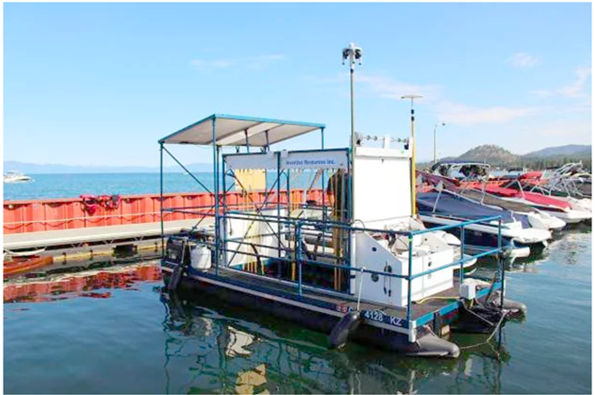Planktonic:
In-water Intervention Strategy
Limited Supporting Field Data
Benthic:
In-water Intervention Strategy
No Available Supporting Field Data
Ultraviolet (UV) exposure is an advanced oxidation technique that is used most commonly to disinfect treated water in process-level treatments where this is a more established technique. UV exposure works by transferring electromagnetic energy from a UV bulb to stop organisms from reproducing by inactivating their DNA. UV-C light is typically used in treatment processes due to its short wavelength (190–280 nm). This type of UV light is highly energetic and has strong mutagenic effects on the DNA of most organisms (Pattanaik, Schumann, and Karsten 2007). UV exposure has been experimentally shown to oxidize microcystins and cylindrospermopsin but at extremely high doses that are not feasible for an in-field application (USEPA 2019). UV exposure has been shown to be effective at oxidizing cyanotoxins in production-scale treatment operations when used in tandem with a catalyst, such as hydrogen peroxide (Afzal et al. 2010).
Using UV light to control HCBs in surface waters is not an established technique. Some studies have shown experimentally that UV exposure can inhibit HCB growth (Alam et al. 2001, Sakai et al. 2007). While Alam et al. (2001) reported that boats equipped with UV lamps were used in several eutrophic lakes in Japan to control algal growth, detailed reports of field data could not be found. Currently, this approach is considered limited due to a lack of validated field applications specifically for HCBs. An alternative application strategy is the deployment of boats with UV lamps to stunt the growth of an active bloom. As reported indirectly in Alam et al. (2001), boats with UV lamps show some feasibility for smaller, shallow lakes. This approach has been piloted in Lake Tahoe to control invasive weeds (Tahoe Resource Conservation District 2018).
| PLANKTONIC AND BENTHIC |
|
EFFECTIVENESS
|
|
NATURE OF HCB
|
|
ADVANTAGES
|
|
LIMITATIONS
|

Figure 1. This boat built by Inventive Resources has a panel of UV lights that is lowered to expose aquatic invasive plants to UV light.
Source: Cudahy (2017).
COST ANALYSIS
Large-scale use of UV treatment on a process scale is expensive, but it is less costly than other advanced oxidation and disinfection processes (Dore et al. 2013). There are few cost analyses for UV exposure via boat, specifically for management of HCBs. Labor costs for UV exposure for invasive weed control in Lake Tahoe were estimated at $28,000 for a UV-C treatment system 160 sq. feet across 1 acre (Tahoe Resource Conservation District 2018); capital costs were not provided.
Relative cost per growing season: UV exposure
| ITEM | RELATIVE COST PER GROWING SEASON |
| Material | $$$ |
| Personal Protective Equipment | $$ |
| Equipment | $$$ |
| Machinery | $$$ |
| Tools | $$$ |
| Labor | $$$ |
| O&M Costs | $$$ |
| OVERALL | $$$ |
REGULATORY AND POLICY CONSIDERATIONS
Using UV exposure to treat HCBs in the field may require permitting and reporting. From the Lake Tahoe example, permits were acquired from the Tahoe Regional Planning Agency, and an authorization letter was obtained from the U.S. Army Corps of Engineers. Other regulatory agencies (the Lahontan Regional Water Quality Control Board and California Department of Fish and Wildlife) were contacted and offered consent or requested incorporation of specific monitoring parameters (Tahoe Resource Conservation District 2018). Process-level applications for use of this technique would likely require permitting similar to the procedures above.
REFERENCES
Afzal, A., T. Oppenländer, J. R. Bolton, and M. G. El-Din. 2010. “Anatoxin-a degradation by advanced oxidation processes: vacuum-UV at 172 nm, photolysis using medium pressure UV and UV/H(2)O(2).” Water Research 44 (1):278-86. doi: https://doi.org/10.1016/j.watres.2009.09.021.
Alam, Z. B., M. Otaki, H. Furumai, and S. Ohgaki. 2001. “Direct and indirect inactivation of Microcystis aeruginosa by UV-radiation.” Water Research 35 (4):1008-14. doi: https://doi.org/10.1016/s0043-1354(00)00357-2.
Canonica, S., L. Meunier, and U. von Gunten. 2008. “Phototransformation of selected pharmaceuticals during UV treatment of drinking water.” Water Research 42 (1-2):121-8. doi: https://doi.org/10.1016/j.watres.2007.07.026.
Cudahy, Claire 2017. “Pilot program kills invasive aquatic plants in Lake Tahoe with UV light.” Tahoe Daily Tribune. https://www.tahoedailytribune.com/news/pilot-program-kills-invasive-aquatic-plants-in-lake-tahoe-with-uv-light/.
Dore, Mohammaed H., Rajiv G. Singh, Arian Khaleghi-Moghadam, and Gopal Achari. 2013. “Cost differentials and scale for newer water treatment technologies.” International Journal of Water Resources and Environmental Engineering 5 (2):100-109.
Pattanaik, Bagmi, Rhena Schumann, and Ulf Karsten. 2007. “Effects of Ultraviolet Radiation on Cyanobacteria and their Protective Mechanisms.” In Algae and Cyanobacteria in Extreme Environments, edited by Joseph Seckbach, 29-45. Dordrecht: Springer Netherlands.
Sakai, Hiroshi, Kumiko Oguma, Hiroyuki Katayama, and Shinichiro Ohgaki. 2007. “Effects of low- or medium-pressure ultraviolet lamp irradiation on Microcystis aeruginosa and Anabaena variabilis.” Water Research 41 (1):11-18. doi: https://doi.org/10.1016/j.watres.2006.09.025.
Tahoe Resource Conservation District. 2018. Aquatic Invasive Plant Control Pilot Project Final Monitoring Report
USEPA. 2019. “Cyanobacteria and Cyanotoxins: Information for Drinking Water Systems.” U.S. Environmental Protection Agency. https://www.epa.gov/cyanohabs/health-effects-cyanotoxins.


